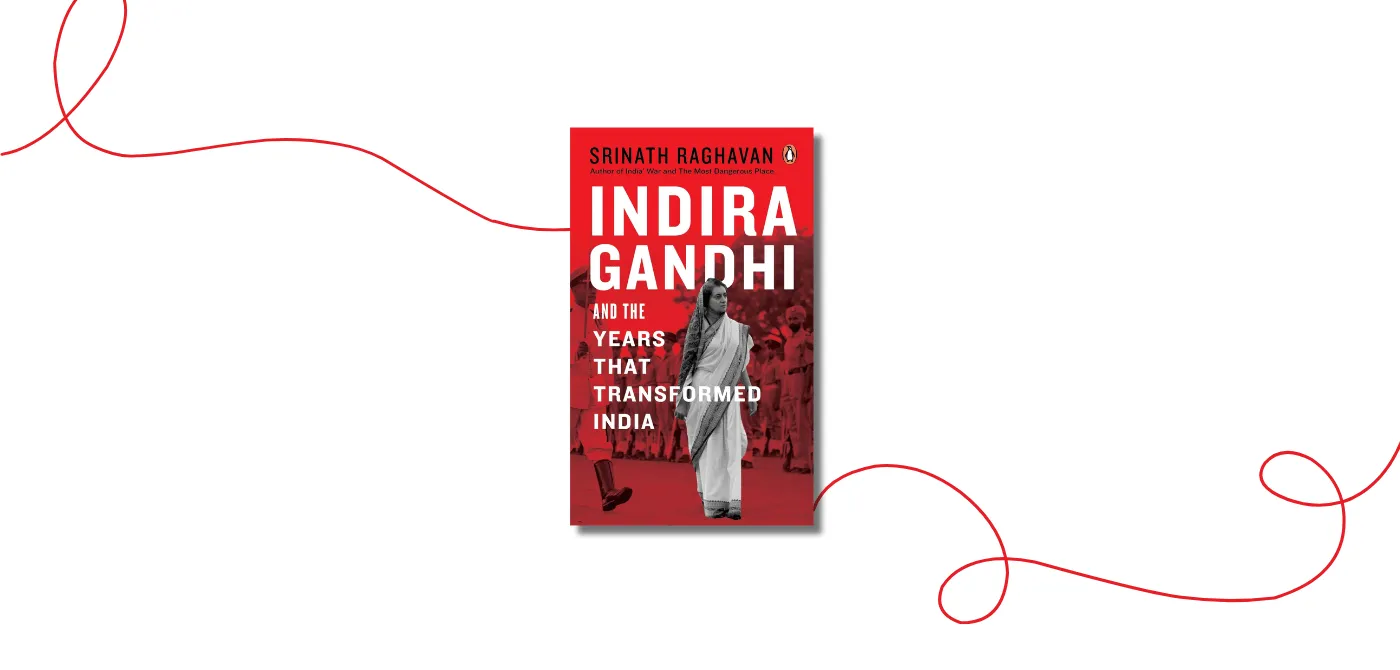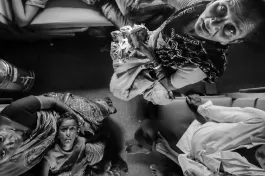Srinath Raghavan’s Indira Gandhi and the Years that Transformed India opens with a prologue that reads like a movie script. It serves as a trailer for what is to come, drawing readers into the rough and tumble of Indian politics. This authoritative narrative of a critical period in modern India’s democratic journey spans 12 chapters, including a prologue and epilogue. It attempts to chart Mrs. Indira Gandhi’s political career from the late 1960s to her assassination in 1984.
Everything Indira Gandhi did, decided, or enacted, as well as the individuals she chose to promote or sideline can only be understood within the context and circumstances of the long 1970s.
Raghavan frames this period, the “long 1970s”, as a transformative era bridging the post-Independence years with the contemporary era. As the book compellingly shows, it marked a pivotal chapter in modern India’s democratic journey. This period was marked by defining events like the Emergency, the electoral defeat of the Congress, the first non-Congress government coming to power at the centre, economic and foreign policy shifts, and much more.
With so much ground covered, an exhaustive review is impossible. I will therefore focus on two dimensions that resonated most deeply. Both challenge the now fashionable use of populism to make sense of political leadership across the world, including that of Mrs. Gandhi.
First, Raghavan uses a distinctive framework to connect Mrs. Gandhi’s politics with the evolution of Indian democracy. His choice to invoke the concept of Caesarism, instead of relying on the clichéd notion of populism, is both refreshing and analytically sophisticated. Second, Raghavan’s analysis of Mrs. Gandhi’s economic policy shifts moves beyond populist explanations. He offers a more nuanced and insightful interpretation.
I first sketch the immediate context of Mrs. Gandhi’s ascent to power. Then I unpack the core analytical framework, and finally I examine the policy shifts in the economic sphere.
The long 1970s
Let’s begin with the context. The long 1970s were a period when the initial excitement of Independence had worn off and reality had begun to set in. The planned development programme struggled to meet the growing demand for employment, food, and tax revenue. At the same time, global headwinds strained the economy. Further, the Cold War raised questions about India’s foreign policy, squeezing it into a tight corner. This created what Raghavan calls the three interrelated crises of hegemony, representation, and governance.
In his approach to historiography, Raghavan departs from personality-centric explanations that emphasise and psychologise individual traits, such as charisma.
The crises were starkly embodied in the Congress party’s losses in the 1967 elections. The party’s ability to deliver on its promises and handle the complexities of governance amid the unfolding economic challenges was questioned. To preserve its authority, the state relied on the use of force and extraordinary provisions in different parts of the country, signalling that its governance capacity and hegemonic power were diminishing.
These crises led to multiple transformations. At the societal level, this sparked what later came to be known as the “first democratic revolution”, in which the recently economically empowered intermediate castes sought a greater political voice. Politically, this led to the transformation of the party system, with the emergence of new parties representing these new interests that challenged the dominance of the Congress party. Economically, as the planned development programme stalled, it created space for redefining the boundaries between the state and the market.
In his approach to historiography, Raghavan departs from personality-centric explanations that emphasise and psychologise individual traits, such as charisma. Instead, he stresses that Mrs. Gandhi and everything she did, decided, or enacted, as well as the individuals she chose to promote or sideline can only be understood within the context and circumstances of the long 1970s. He argues that this period, whose issues still shape contemporary India, represents a truly critical juncture in modern Indian history.
Caesarism
Having laid down the context, Raghavan invokes the concept of Caesarism to make sense of Mrs. Gandhi’s politics, implicitly drawing on Weberian and Gramscian interpretations of the term. While both frameworks address the rise of undemocratic leadership, they differ in their focus.
In the Gramscian sense, the situation is historical. Mrs. Gandhi is portrayed as a product of crisis: a moment when the old order was challenged by the rise of intermediate agrarian castes. This development posed a direct threat to the dominance of the Congress. As a result, the established rules of the game were questioned, causing a period of instability marked by defections and short-lived governments. In this interpretation, Mrs. Gandhi’s actions can be seen as an attempt to restore order by creating a new equilibrium.
Mrs. Gandhi, faced with what Gramsci would describe as a crisis, responded by making a plebiscitarian turn and thus became Caesarean in her leadership.
In Weberian terms, Caesarism is used as a typological concept. According to this understanding, all democracies display plebiscitary tendencies, but these tendencies were especially pronounced in Indian democracy during the long 1970s. Mrs. Gandhi, faced with what Gramsci would describe as a crisis, responded by making a plebiscitarian turn and thus became Caesarean in her leadership. This Caesarean approach led to the undermining of parliamentary and other institutions, bypassing established principles of democratic accountability.
By synthesising Gramsci and Weber, Raghavan creates a complex analytical framework, one that neither perspective could offer on its own.
Caesarism enables him to both explain the rise of Mrs. Gandhi and underline the limitations of her politics, while also, albeit subtly, to illuminate their echoes in the contemporary. This restraint allows the careful reader to draw parallels that the author hints at. This makes the reading interactive, it invites the reader to examine the contemporary, to catalogue, compare, and reach conclusions.
First, to make Mrs. Gandhi who she was, the Congress allowed the destruction of its organisation and entrenched dynastic succession without considering that popularity, a personal trait, was incapable of being passed on to Mrs. Gandhi’s successor. This model of party organisation has since become the default model in the country today, where dynastic succession is taken as given in most political parties.
Second, winning elections became the sole claim to legitimacy and greater numbers are equated with stronger forms of consent. Fighting elections has become the core political activity of political parties, and the electoral calendar often drives party choices and decisions. The proposed solution of one nation, one election is a cure worse than the disease. It is only likely to exacerbate Caesarean tendencies.
At the same time, the Emergency was not a plain power grab, but a desperate attempt by the Congress to preserve its legacy as the protector of the freedom struggle’s vision of national unity, secularism, social justice, and so on.
However, by resorting to authoritarianism, Mrs. Gandhi ultimately betrayed the very principles she once championed. Today, this shift has opened the door to an egregious form of majoritarianism, pushing the country further away from its constitutional values. Instead of defending these values, the current approach is to forge a new cultural and political identity, one justified, yet again, by an appeal to popular will.
While she set out to defend what she thought were the core values of the Constitution, the freedom movement and her own party, her choice of tools ultimately went against these ideals.
Third, Caesarism challenges and severely weakens the existing checks and balances of the system. The weakening of Parliament and the judiciary, as well as the instrumental use of the bureaucracy for personal and narrow objectives, centralisation and emasculation of federalism, among others, enabled Mrs. Gandhi to strengthen her position. The legacy of the long 1970s still prevails, where institutions remain fragile, and subtle authoritarianism, in the form of media control and surveillance, echoes the past.
Fourth, this personalised rule, depending on technocratic solutions, only exacerbated the representative crisis. From the expert-driven poverty reduction and population control measures of Mrs. Gandhi, today the NITI Aayog has a “nudge unit” to reform policy making. Likewise, the paternalistic thrust continues, while previously it was the Planning Commission experts who decided what was good, now it is an expert economist. The leader simply justifies policies as being suitable for the people.
Garibi Hatao
Finally, was Mrs. Gandhi a socialist and a populist? “Garibi Hatao, Desh Bachao”, the Congress party’s slogan for the 1971 elections, is often seen as a hallmark of Mrs. Gandhi's populist streak. In sharp contrast to the narratives that inevitably brand Mrs. Gandhi’s regime populist, Raghavan pointedly avoids the term altogether.
Mrs. Gandhi was concerned about the poor, and as a consummate politician, it would be politically imprudent to ignore the massive, impoverished population. However, she certainly did not construct them as a homogenous mass antagonistic to a “corrupt elite” or think in terms of them having a “general will” or some innate “common sense”, as in standard definitions of populism.
In sharp contrast to the narratives that inevitably brand Mrs. Gandhi’s regime populist, Raghavan pointedly avoids the term altogether.
Raghavan argues that her policies on poverty, food controls, inflation, bank nationalisation, and industrial regulation, as well as monetary and fiscal controls, were guided by economic logic and technocratic insights, all of which pointed to the fact that the early developmental state had failed to deliver. In his reading, Mrs. Gandhi’s economic positions and policy lines were pragmatic fixes to inherited problems such as low food production, inadequate production and manufacturing capacity, low availability of credit, unemployment, and poverty. They were not coming solely from a rigid ideological or even strategic positioning.
To illustrate this point, he draws on Mrs. Gandhi’s scepticism towards “organised labour’s militancy” and the way she violently dealt with the 1974 railway strike (pp. 140–143), showing how far removed she was from what socialism textbooks would suggest. Mrs. Gandhi in Raghavan’s reading was therefore neither a populist nor a socialist.
This is not, however, to deny that these policies did serve as useful ideological and strategic weapons in her battle against the party old guard and in her quest for a distinctive position for herself. Early in the book, he captures this inner drive of Mrs. Gandhi.
He notes that there “was a deep yet inchoate desire to be her own person: not her father’s daughter, or the prime minister’s assistant, or yet an empty vessel into which older congressmen could pour their interests and ambitions” (p. 16). Her policies, therefore, should be seen as bold assertions of an ambition to carve out a legacy of her own.
Slotting her as populist or socialist arises when we look at phases in her tenure isolated from each other. Many scholars have made a distinction between Mrs. Gandhi before and after the Emergency. They have argued that the direction for economic liberalisation was set by Mrs. Gandhi when she returned in 1980.
The bigger picture
Raghavan urges us to step back and consider the bigger picture when evaluating Mrs. Gandhi’s economic policies. He argues that a business-friendly approach was present even during her most socialist and pro-poor period. According to him, this perspective may explain why, apart from her anti-poverty measures, she soon abandoned a statist economic path in favour of one that was more supportive of business interests.
Indira Gandhi created space for a set of deep transformations: in the political system, the mode of politics, and political economy.
Here, again, Raghavan is careful to emphasise that Mrs. Gandhi’s moves were business-friendly and not necessarily market-friendly. This distinction is important. Her policies were still protectionist and did not necessarily open the economy to the outside world. They only eased the domestic constraints for those working within the system. This pro-indigenous business approach, rather than an open market-friendly position, has become a staple for all governments, although the degree of market friendliness has varied over time.
In this book, Mrs. Gandhi emerges as a complete politician at ease with ruthless strategic manoeuvring. While she set out to defend what she thought were the core values of the Constitution, the freedom movement and her own party, her choice of tools ultimately went against these ideals. In the process, she created space for a “set of deep transformations: in the political system, the mode of politics, and political economy” (297), whose consequences contemporary India still encounters.
Raghavan draws from a wide range of sources. These include the Prime Ministers’ Museum Library, the National Archives in both India and the UK, the World Bank Group Archives, select libraries in the United States, official publications, memoirs, autobiographies, letters and diaries, and various secondary sources.
The book is excellently produced. It features a list of characters, a chronology of events, and an invaluable index that helps readers find exactly what they are looking for. For PhD students, this book serves as an exemplary model of rigorous, context-driven research. At the same time, it shows how scholarship can be made accessible to non-specialist readers.
K.K. Kailash is with the Department of Political Science, University of Hyderabad.









